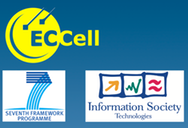The electronic activation of replication via microelectrodes involves two key processes : dehybridization and ligation.
Methods to accomplish electrically programmable release of duplex strands
will be developed. These will include the electronically induced pH changes in
the replication volume by redox-active monolayers or thin films associated with
the electrode.
Electrically triggered oxidation of sulfhydryl bonds to disulfides will be used for the programmable ligation of the replicated duplexes. Towards this goal, vitamin B12 analogs, known to oxidize –SH groups to S-S bonds (Mimica, D., Bedioui, F., Zagal, J.H., Electrochim. Acta, 2002, 48, 323-329.) will be immobilized on electrodes to electrocatalyze the reaction. Co(III)-protoporphyrin IX will be assembled on electrodes, and it will be used as an electrocatalyst for the ligation of sulfhydryl groups. The research will include the primary elucidation of the electrochemistry involved with the electrocatalyzed oxidation of thiols. After the optimization of the process, it will be applied to oxidize thiolated oligonucleotides.
